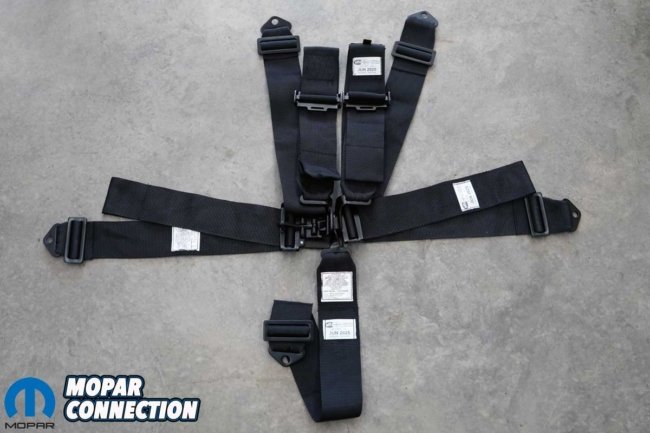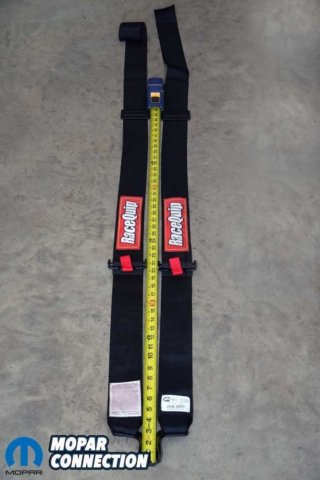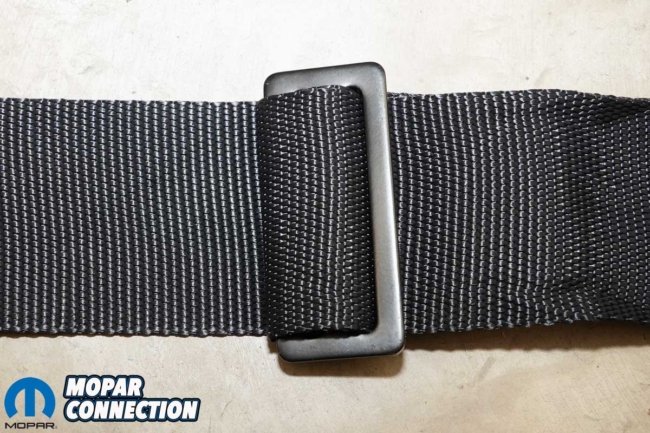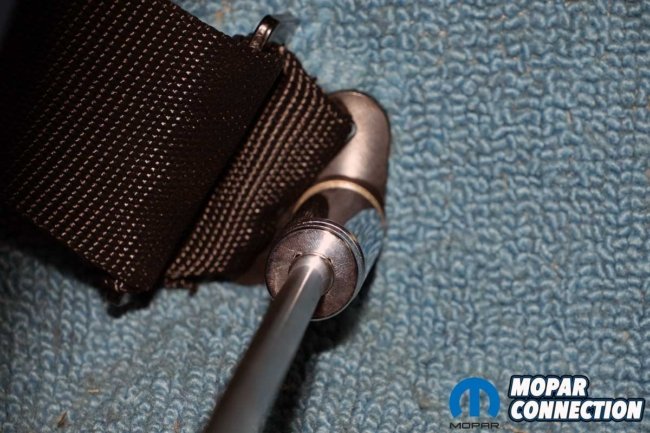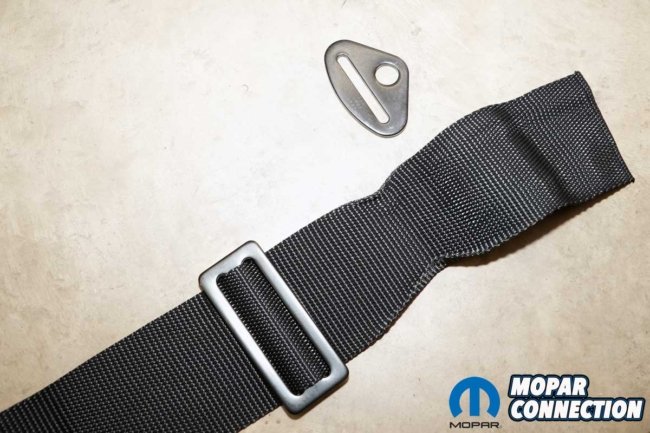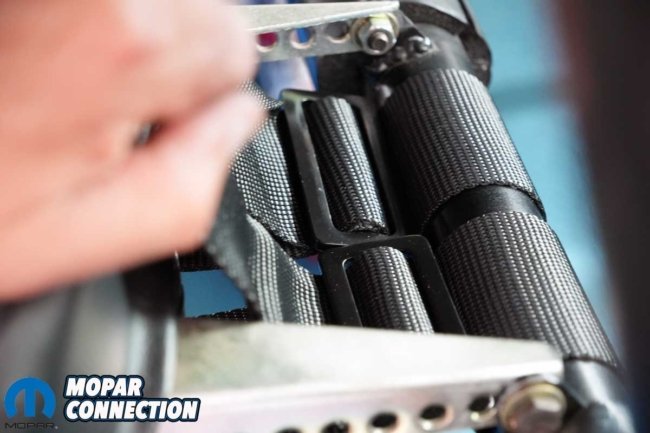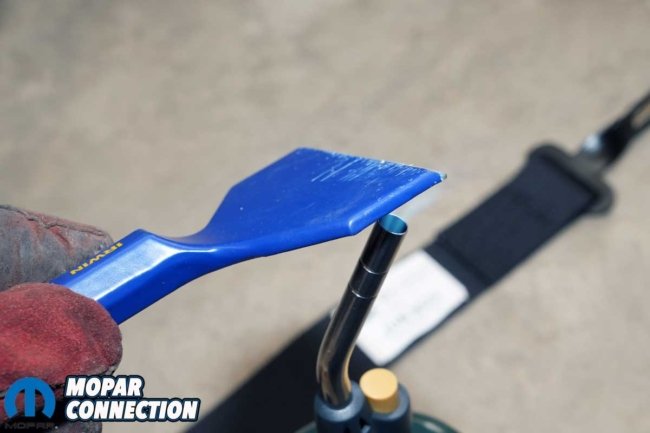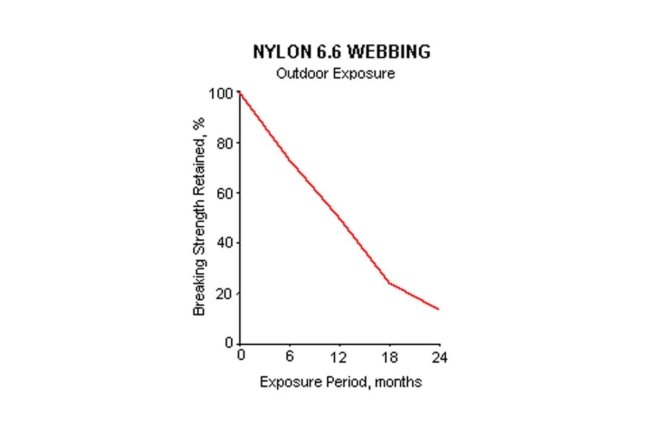
Seat belts – everybody knows what they are and should be using them. However, with the chimes, buzzers, flashing dash lights, and limited use of specific options on top of the mountains of Federal and state laws, some people still refuse to wear them. Regardless of a person’s preference to wear or not a seat belt while driving on public roads, seat belts are required when it comes to automobile racing, irrespective of the sanctioning body.
Above Left: Our ’69 Dart’s SFI seat belt assembly has reached the end of its two-year certification, so we sent the harness to be re-webbed and recertified. Above Right: Our belts were returned with cleaned hardware, new webbing, and new SFI spec. 16.1 certification stickers on the belts.
With our focus on drag racing, three national bodies have similar but specific seat belt regulations:
- National Hot Rod Association (NHRA)
- International Hot Rod Association (IHRA)
- World Drag Racing Association (WDRA)
We have raced our 1969 Dodge Dart at hundreds of drag race events over the years, and each time, before making a pass down the track, it must pass the track’s technical inspection. One of the criteria that will result in an automatic failure is a lack of seat belts, damage to the belts, improper mounting, and race-specific belts that are out of certification.
Above Left: Our old belts appeared in great shape, but all the drag racing sanctioning bodies require updated belts to race at their respective events. SFI-approved belts are needed when the vehicle reaches elapsed times below a certain number or speeds exceeding a specific miles per hour. Above Right: Years ago, we selected the roll bar wrap-style fastening of the belts rather than attaching the shoulder belts with hardware.
It is crucial to understand that if your race seat belts are not certified, they have yet to be evaluated and approved to meet the necessary safety standards for racing. The lack of certified belts can significantly increase the risk of injury in an accident, a possibility that no racer should be willing to take.
A restraint assembly consists of multiple belts, each with a specific function. The shoulder harness is a belt assembly with a single strap for each shoulder. It is intended to restrain movement of the shoulder regions and upper torso. In specific applications, an optional cross strap extending from each shoulder harness across the chest can be used to hold the shoulder harnesses together.
Above Left: We made measurements of the old shoulder belts so that when the re-webbed belts returned, we could quickly adjust them to the same length. Above Right: The lap and submarine belts were also measured, and we noted the lengths for the reassembly.
A two-part lap belt restrains movement of the pelvis, and the anti-submarine strap that extends from the floor through the seat and between the driver’s legs prevents the pelvis from slipping forward from under the lap belt in the event of an accident.
Once a vehicle reaches a specific elapsed time or speed, indicating the need for a roll bar or roll cage, race-dedicated seat belts with a five-, six-, or seven-point design must be incorporated. These seat belts must meet a series of stringent requirements set by the SFI Foundation, INC. before they can be certified. The certification process is not just a formality but a crucial step in ensuring the safety and reliability of the equipment.
Above Left: When setting up the lap belts, we slipped the belt webbing into the slide bar and then out of it, making sure to cross the center part of the slide bar. Then, we extended the webbing through the floor anchor while folding the edges of the belt inward. Above Right: We continued by running the webbing back through the slide bar.
Above Left: We continued by slipping the belt webbing through and out of the slide bar to complete the assembly. Above Center: Although unnecessary, we prefer to loop the belt webbing back over and through the slide bar. Above Right: The assembly is complete, and the belt is ready to be installed.
The requirements for roll bars or cages, as well as seat belts, can vary slightly from one sanctioning body to another. The variation is not to confuse but to cater to the specific safety needs of different racing environments. There are also particular requirements for various types of vehicles, such as convertibles, T-tops, and hardtops/sedans.
Furthermore, late-model Challengers, Chargers, and 300s have different roll bar and seat belt requirements due to their enhanced crashworthiness, a feature that cars before the 1990s did not have. It is best to consult the sanctioning body under which you will be racing to ensure you are up to date with the requirements for your vehicle.
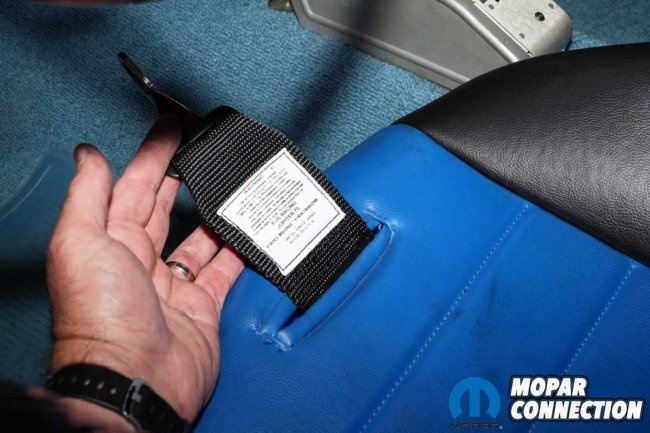
Above: All the data about the belts is listed on the submarine belt. A disclaimer, re-webbing company, and the country of origin are listed. These belts are constructed in the U.S.A. Not all belts are webbed or re-webbed in the U.S.A. For the first time, the submarine belt is a 3-inch width rather than customary two inches.
All vehicles that require race belts must use an SFI 16.1 or 16.5 driver restraint system. The belts must be attached to the frame or reinforced mounting points on the vehicle. In an emergency (after an accident) where the belts must be quickly removed, the buckle, which attaches the belts together, should have a swift and uncomplicated release mechanism.
Only three types of buckles are approved: the latch/lever, which can be opened by pulling a lever; the turn/push, which can be opened by turning or pushing a button; and the cam lock, which can be opened by releasing a cam mechanism. Each of these buckles is designed to allow for quick and easy removal of the seat belts in emergencies, enhancing driver safety.
Above Left: The left side lap belt is secured through the floor anchor to the factory mounting location on the Dart. Above Right: The right-side lap belt is secured to the reinforced factory mounting point.
The two-year replacement rule, often a point of contention among racers, is in place for a specific reason. Once the harness assembly has passed rigorous testing, the manufacturer installs SFI certification tags on the belts, displaying the manufacture date. The only purpose of the dated certification tags is to enable tech officials and the driver to know the date the belts have reached their two-year life span, ensuring that they are always in optimal condition for your safety.
One of the specification’s most essential requirements states that the useful life of the webbing in the straps of the restraint assembly shall not exceed two years, and the belts must be replaced at or before that time. The belts must be returned to the original manufacturer at the end of the two years.
Above Left: The shoulder belts come with the roll bar anchor installed, but as mentioned earlier, we do not employ that type of installation on our car. Above Right: The removal of the anchor is simple. We merely unthreaded the slide bar and slipped the anchor off the belt.
The manufacturer will then re-web the belts, a process that involves replacing the worn-out webbing with new, certified webbing, ensuring the belts meet the necessary safety standards for another two years of use. In addition to this, it is essential to regularly inspect your seat belts for any signs of wear or damage and to clean them according to the manufacturer’s instructions to ensure their longevity and effectiveness.
With the seat belt lesson complete, the two-year window has caused us to update our belts yet again. We removed all five belts from our Dart and sent them to the original manufacturer for re-webbing. Another option is to purchase a new harness assembly from Summit Racing, Jegs, or your favorite supplier. The difference in cost of shipping the belts back, having the buckle and mounting assemblies inspected, inserting new webbing, and return shipping is minimal between the two options.
Above Left: We extended the shoulder belts through the seat and looped them around the crossbar of the roll bar. As previously explained, we secured the belts by passing the webbing through the slide bars multiple times. Above Right: After passing the webbing back through the slide bar an additional time, we rolled up the excess webbing and zip-tied it so it would not flap around.
The belt design we selected years ago has mounting hardware for the lap belts, submarine belt, and shoulder harnesses that pass through the seat and loop over the roll bar cross support behind the seat. Rather than mounting hardware, the looping process wraps the belts around the roll bar and secures them with two rings per belt, like tightening a motorcycle helmet strap.
When we installed the roll bar in 2005, we located the shoulder belt restrain approximately three inches below our shoulder height and installed the submarine belt’s location behind the centerline of our chest. Both locations met the requirements of all the sanctioning bodies. Thus, we currently do not need to change the mounting points.
Above Left: If we had elected to shorten the excess belt length, cutting the webbing with scissors or a razor is not recommended. The webbing could continue to fray and fail if the fraying extended into the restraining portion of the belt. Cutting and melting the webbing is a better idea. We heated a 4-inch chisel to provide a clean cut and melt the belt simultaneously. Above Right: With an extremely hot chisel, we cut through a scrap belt to demonstrate the process.
Above Left: The cut is precise and clean. Plenty of heat and pressure on the chisel will effectively cut the belt. Above Right: The end of the webbing is melted, and it will not fray. We could have placed the heated chisel over the end of the webbing to melt it even more, if necessary.
The installation required us to adjust the submarine belt to the proper length. The shoulder belts were also tweaked to achieve the appropriate fit over our shoulders while retaining adjustability to restrain us properly. Once all the belts were installed, we assessed the fit by latching the belts together and sinching each belt.
Above Left: SFI has developed a chart that explains the reason for the two-year certification window. The diagram shows that the breaking strength retention percentage drops significantly as the exposure period, measured in months, extends toward the two-year limit. Above Right: Your author is secured in the Dart and compliant with all the sanctioning bodies for two more years.
The harness assembly fit our body well and properly secured us into the seat. It is important to note that the correct installation of seat belts is just as necessary as their certification, as an improper installation can significantly reduce their effectiveness in an accident.
And just like that, we are belt complaint for two more years. With new belts, getting to the track more often is a good excuse.



